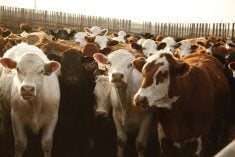At Gordon and Elaine Young’s bed and breakfast, they know one of the first things guests want to see are their bison and reindeer.
The central Alberta couple was in the cattle business for years before they made the switch to something different.
They bought nine reindeer from Canadian Rocky Mountain Ranch outside Calgary and soon added bison and white-tailed deer. The animals were a perfect fit for their vacation farm near Leslieville.
“Christmas time is wonderful when you have reindeer,” she said.
Read Also

Growth plates are instrumental in shaping a horse’s life
Young horse training plans and workloads must match their skeletal development. Failing to plan around growth plates can create lifelong physical problems.
“You bring in Santa and Mrs. Santa and you have them eating out of your hand.”
Young is secretary-treasurer of the Alberta Reindeer Association and along with other producers, hopes to build up the herds for commercial meat production.
Since the industry is relatively new to Alberta, reindeer owners must obtain a temporary shelter permit from the province and follow game farm guidelines that specify handling, fencing and velvet removal.
Few have removed velvet because the market is soft. Similar in value to elk velvet, the antlers are ground up and made into capsules for the alternative health market.
Long domesticated in Lapland and Russia, reindeer are docile and relatively easy to handle compared to other game animals.
Alberta reindeer were imported from British Columbia and the Yukon.
The original reindeer came to northern Canada from northern Europe and fed the Inuit in the nineteenth century.
“Some people call them caribou or reindeer. They are not really the same,” Young said.
The animals are vigorous and well adapted to cold weather. A mature bull can reach 400 pounds and among the cervids, which include moose and elk, the reindeer carries the largest antlers relative to body size.
The species is somewhat unusual in that bucks, does and calves grow antlers.
Antler size is a consequence of good nutrition.
Measuring antlers is a good evaluation tool to measure one aspect of quality, said Canadian Rocky Mountain Ranch manager Terry Church.
Measuring provides a numerical score for antlers that can be recorded. Among hunters these scores are recorded in registries such as Boone and Crocket and the Safari Club International.
When scoring antlers, the inside spread between each outgrowth is measured, as well as the length of the tines. Brow tines are also measured.
Good velvet antlers may not equal the kind of hard antlers valued by trophy hunters.
“It is not an exact correlation with velvet production,” Church said.
Antlers should not be confused with horns. Derived from Latin, the word antler means “sheds annually.” It is made of cartilage, unlike horns that are made up of skin and hair.
Including this year’s fawns, there are 75 reindeer at the Rocky Mountain ranch, which is aiming for commercial meat production.















